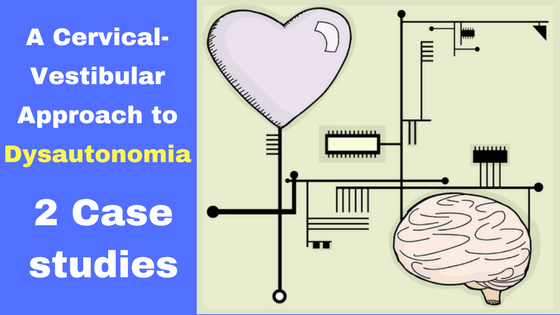A Cervical-Vestibular Approach to Dysautonomia: 2 Case Studies
Thanks to the readers of our blog, our office has become a place where patients with dysautonomia are seeking care with the hopes of improving their quality of life. Many patients with dysautonomia often struggle with widespread body pain, dizziness, brain fog, and headaches to go along with their primary symptoms of feinting, persistent light headedness, or rapid heart rate.
Today we’re going to breakdown the success we’ve had with 2 recent patients with dysautonomia.
Case 1
This patient started with us back in June 2017. She got hit with dysautonomia after coming back from a trip where she had a bout with malaria. She’s had times where the her dizziness and fatigue were so bad that she had to be pushed in a wheelchair to get around. Her heart rate is consistently over 100 beats per minute with routine standing. When she came to our office her biggest problem was that whenever she stood up from seated, she would start to get dizzy, feel feint, and sometimes black out. This made it difficult for her to go to church, take a shower, and other really basic activities of normal living.
She showed dysfunction in her neck at the atlas vertebra and some past history of whiplash. She also had a large amount of difficulty just following moving objects with her eyes alone and it made her vision blur repeatedly.
We started by performing a correction of her Atlas and after her first visit she was able to go from seated to standing without having her vision go dark and pass out.
As her cervical spine maintained the correction, we began doing exercises for her eyes and vestibular system to help her brain orient itself to the environment accurately again.
As she performed the exercises more frequently, she was able to track moving objects better and she was able to tolerate standing for 15-20 minutes without feeling tired or feint.
You can see her in her own words below.
Case 2
After case 1 got really great improvements, she referred her mother to our office to see if we could help her in a short amount of time. Case 2 also had dysautonomia throughout her life. She had it many years ago and was frequently dizzy and had difficulty with standing and fatigue. She went into remission for a number of years when the symptoms started to come back. She also got into a car accident which seemed to intensify the symptoms again. She flew in from North Carolina to be seen and evaluated.
We knew we would only be able to work with her for a week at a time so we opted to do some more intensive care seeing her for multiple sessions in a day initially. Fortunately, being fast responders to NUCCA corrections seems to be a family trait.
We identified problems in the upper neck as well, and while her eyes were not moving as poorly as case 1, she had some issues tracking objects certain head positions would cause vertigo.
After her initial visits, she was able to maintain better balance and bend forward without getting dizzy. She also started to notice improvements in pain throughout her body.
On her third time visiting, she was able to jump and move with significantly less feeling of imbalance.
How Does This Work for Dysautonomia Symptoms?
So why does cervical and vestibular work seem to help with dysautonomia? It seems that some cases of dysautonomia can be tied back to an inability of the brain respond appropriately to gravity. Many primary dysautonomia cases like POTS have a postural component to it (hence Postural Orthostatic Tachycardia Syndrome). When the body moves into different positions in gravity, an inappropriate response occurs such as an extremely rapid heart rate or a blood pressure that tanks.
This is relevant because the cervical spine and your inner ears are really big players in how your brain recognizes gravity. If one inner ear senses more gravity than the other, then your brain is going to think that it is tilting or turning when you are really just sitting straight. If the joints of the neck are malfunctioning, then you are going to have abnormal muscle patterns that also provide a misrepresentation of where the head is in space.
Vestibular and cervical problems will also cause your eye movements to become dysfunctional too, causing blurring and other visual problems.
This is exactly what we see in a lot of people with concussions too, which is why some researchers are saying that the dizziness and visual problems we see in concussed patients may be a problem with dysautonomia too. Read more about that here:
While dysautonomia is pretty rare and presents with numerous complexities, taking a cervical and vestibular approach to some cases may make a big difference in getting someone’s life back.






Leave a Reply
Want to join the discussion?Feel free to contribute!